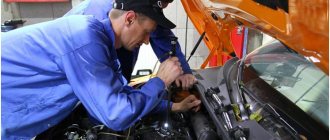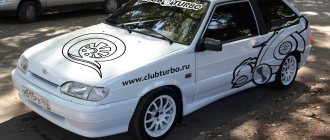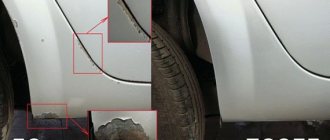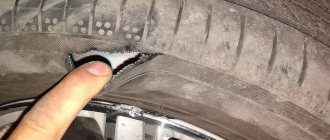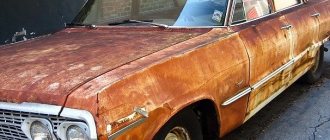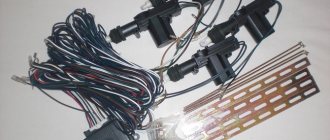Punishment and fine amount for lowered suspension in 2018
In every city it is not difficult to come across a car that attracts the attention of strangers with its excessively low ground clearance. Perhaps those who are not car enthusiasts will not even pay attention to such a nuance. But every driver knows for sure that lowering a car is a popular tuning among young people. Moreover, despite the design changes, such tuning is considered external. It does not impart beneficial characteristics to the suspension and does not adapt it to specific operating conditions. The low landing of the car evokes a purely associative perception. It is known that GT-style tuning, characterized by its body kits and moldings, gives a sporty character to the car, since cars participating in rallies have always been equipped with devices that increase aerodynamic properties.
Lowered suspension has become an alternative solution to give the car a kinetic look. Let us note right away that not every driver has the desire for such changes. And how the traffic police officers don’t like the modifications will be fully felt starting this year. In principle, the legislative framework allowing the operation of cars has not changed, with the exception of minor amendments. But if earlier the traffic police inspector often “turned a blind eye” to his own “adjustments,” today he will see serious violations in this.
This also applies to Lowrider-style cars with air suspension, the so-called dancing cars.
Punishment for lowered suspension
In regulatory documents there is no concept of high or low suspension. The law defines the operation of vehicles that comply with the basic approval provisions. Any deviation from the established standards adhered to by the manufacturer is classified as a violation.
As you know, the set of regulations is represented by the Code of Offenses of the Code of Administrative Offenses of the Russian Federation. There is no separate article that specifically covers lowered suspension on a car, installed independently. In the future, the text of the existing document will also not be revised. But the existing document clearly states that a discrepancy between the actual ground clearance and the technical data of the car by more than 5 cm is considered a malfunction.
Operation of such a vehicle is not prohibited. This means that the vehicle will not be sent to the impound lot. But the driver is obliged to go to the place where the fault is repaired. He is given 24 hours to do this. The original text can be found in Article 12.5 of the Code of Contraventions. The document is dated December 30, 2001 and has registration number 195 of the Federal Law. Currently, it is interpreted in the latest edition dated 02/05/2018.
Article 12.5, which determines the degree of administrative punishment, contains a reference to the “Basic provisions for the admission of a vehicle to operation.” These provisions, together with the provisions “On Traffic Rules”, were approved by Government Decree No. 1090, as last amended on February 13, 2018. In the above provision there is no separate paragraph devoted to the condition of the suspension. But paragraph 7.18 states that “Changes have been made to the design of the vehicle without the permission of the State Road Traffic Safety Inspectorate...”.
The traffic police inspector, having discovered a discrepancy in the suspension parameters, will consider this situation as a violation of Government Decree No. 1090 under paragraph 7.18, as a result of which, according to the Code of Administrative Offenses and Article 12.5, the driver faces a warning or a fine. The amount of the fine today is minimal, as it is 500 rubles. All speculation about the detention of the car or the removal of license plates has no basis. And such actions of a traffic police officer are considered unlawful.
Several ways to increase ground clearance
- replacing car springs with stiffer ones;
- installation of tires with a higher profile;
- installation of interturn spacers on springs;
- installing spacers on car struts;
- installing spacers between the spring and its support cup.
We do not recommend that you increase the car's ground clearance using the first method, since, firstly, there can be no talk of any comfort when driving on stiff springs. Secondly, the body and suspension will be subject to shock loads of greater force than with standard springs. Installing intercoil spacers on the springs of a car leads to the fact that the springs will become longer and stiffer, so the result will be similar to installing stiffer springs on a car, differing only in price since intercoil spacers are still much cheaper than springs.
The second way to increase ground clearance is not always possible to implement, since the car’s wheel arches are often small for higher tires. So how to increase ground clearance?
Installing spacers on racks can be done with your own hands in a regular garage. This procedure is best for raising the car.
Required tools and materials
- set of sockets and spanners;
- spring ties;
- steering wheel end remover;
- hammer;
- jack;
- WD-40, lithol;
- stands for a car, or scraps of thick wooden beams.
Installation process
So, you decided to lift the car a little and do it yourself.
First you need to decide: you need to lift only the front or along with the stern. If the front of the car is raised to more confidently overcome small obstacles, then the rear part is usually lifted for cars that often have to transport heavy loads. After solving this issue, you will have to go to the auto parts store. Spacers for the front of the MacPherson-type suspension look like aluminum or textolite washers that repeat the shape of the upper support of the strut, with holes for mounting studs.
How to get a warning?
The specificity of the work of traffic police officers is such that, given the available alternative to administrative punishment, they often resort to the most severe penalties. A warning or fine is provided for tuning the suspension. Tacit agreement with the protocol will certainly lead to loss of money. The reason is insufficient information to the driver regarding this violation. Knowledge of the laws can sometimes significantly reduce the punishment. So, if the driver reminds the inspector about a possible warning, and also hints at the absence of administrative fines in the next six months, then he may well count on the “mercy” of the government representative.
How to legally make changes to a design?
As we have already seen, the car owner, despite the fact that the car is his property, cannot make changes to the design without the appropriate permission from the traffic police. Sometimes life situations force the owner to take such a step, since the age of the car does not allow it to be repaired in accordance with the requirements. It is necessary to change components or entire units.
A design change means any re-equipment involving the removal of individual components or their replacement with similar ones, often with excellent characteristics. The law provides for the following changes:
- replacement of body parts or the entire body;
- change car color;
- re-equipment of the power unit;
- changes in the number of seats;
- installation of an additional fuel tank;
- change in dimensions;
- improvement of lighting devices.
A separate item is changing the suspension parameters. Here the sawn springs influence the suspension travel, so such transformations can be registered. However, the popular air suspension is also considered a design change if installed independently. To register it, it is necessary to provide tests for controllability and reliability. The driver cannot cope with such procedures on his own, and traffic police officers will refer to the lack of appropriate equipment. In simple words, it is theoretically possible to register air suspension in the PTS, but in practice it is very problematic.
Returning to reducing the stroke, let us present an algorithm of actions for registering changes. On the website of the Economic Commission for Certification you should find information about the centers where the examination of the installed equipment will be carried out. If the expert allows changes to be made to the design, then the next step will be to submit an application to the traffic police. This application indicates the owner’s passport data, data from the car’s title, as well as the parameters of the installed equipment.
It is important to remember that the vehicle must be registered before conversion is carried out. Typically, all work must be carried out at a specialized station that has the appropriate certificate. Only in some cases will the expert allow you to make changes yourself. Next, the owner will have to pay a state fee and undergo an extraordinary technical inspection. Before the final march to the traffic police department, you should obtain an opinion from an expert.
Necessary or advisable?
Car owners sometimes face hopeless situations. A striking example is the discontinuation of not only a car model, but also its components. In such a case, it is almost impossible to find this or that spare part with original characteristics. Here, car conversion is a vital necessity. Suspension tuning – changing the external content. But at the same time the factory settings are lost. Even if the car gains stability on the highway, it will lose traction on a dirt road. It cannot be denied that the factory tunes the suspension with the ability to vary the parameters. But moving away from average values is fraught with a loss of indicators in marginal conditions. In simple words, suspension tuning is not technically justified and is irrational in terms of documentation.
podveska-avtomobilya.ru
Lowering options
1. Buy a ready-made suspension kit. It includes: springs, struts, etc. This is the simplest, most convenient and expensive option, replacing almost the entire suspension at once. It will cost from 12,000+ rubles. This is the safest option, especially if you get quality parts and install everything correctly. If you choose this option, then do not forget about the wheel alignment.
2. The best option is to replace only springs with a smaller turn stroke. This will lower your car and add rigidity, without any harmful consequences for the car. You can also just buy a regular spring, but stiffer and lower. The range of prices is huge, but from about 3k rubles.
3. There is an option to move the spring cup down. But here you are playing the lottery, since it is very dangerous to do it yourself. - You can weld poorly - The stand is not a fact that it can survive high temperatures during welding. But don’t be discouraged, such racks are sold ready-made.
4. Cutting springs. Most people simply cut the coils off the spring. And this should not be done under any circumstances! In this case, the stroke of the rod decreases and when it gets into a hole, the strut does not have enough free play and it hits the body. Also, a sawn spring can become warped and it will also hit the body and spoil the suspension. It has proven itself to be excellent.
5. Helical suspension. The same as a regular suspension, only with the ability to adjust the height. Very convenient and reliable. Brands: GT Pro and Defi. Price: 20k rubles.
6. Air suspension. Air suspension is a device installed on a car, which is designed to compensate for excess load on the car's standard suspension. Usually they are air bags that are installed between the axle and the frame. With its help you can reduce the load on the springs and increase the vehicle's ground clearance. Sitting in the cabin, by pressing a couple of buttons, you can raise or lower your car. It is very expensive and not very reliable, iron springs are one thing, and cylinders are another. I would advise you to buy a rack with a lowered cup and a stiffer spring with the lowering you need. Or if you have the opportunity to buy a screw suspension, then buy it, you won’t regret it.
And in conclusion, watch a very informative video about undervaluing real cars.
Fine for car tuning in 2020
Good afternoon, dear reader.
Almost every car owner makes some modifications and improvements to his “iron horse” over time. For some, the changes are very minor, for example, replacing nipple caps with colored ones. Other car enthusiasts approach improvements more thoroughly and make changes to the engine, suspension, and car body. All of the listed changes relate to tuning (finishing) the vehicle.
This article will talk about what fines a car owner will face for illegal tuning. Let's get started.
pros and cons, common options for how to lower a car |
Over the past few decades, cars have changed significantly, they have become more advanced, their speeds have increased, and in appearance and shape they are more reminiscent of an alien spaceship than a prototype of the first car.
In addition, it can be noted that the ground clearance of modern vehicles has become much lower compared to models that were produced in the last millennium. A whole movement has emerged among motorists called “lowriding”. Representatives of this trend love lowered cars and do everything possible to lower their car as much as possible, making the ground clearance minimal. There were also those who, for one reason or another, carried out lowering the car at home, conducting experiments on their Kalinas and Prioras and other domestically produced models. The results were different; the network has a large number of examples of unsuccessful calculations and examples of “bad” tuning, which brought nothing but problems to its owner.
In this article I will try to cover the topic of lowering cars and talk about the features of this procedure, its advantages and disadvantages, as well as the ways in which a car can be lowered.
Before performing this type of tuning, you should study in detail all the nuances and consequences of this procedure for the car. By lowering the suspension, you increase the load on the shock absorbers; taking into account the quality of the road surface, the owner of a car with a lowered suspension has every chance of ruining the body of his car on the first hole or bump. There is also the issue of winter operation, as you know, our winters are harsh, there is a lot of snow, and sometimes even SUVs are not able to overcome this or that obstacle, not to mention a fairly understated car. Ice accumulates quickly and you simply cannot avoid wheel friction. If you lower it very low, then you and your car will have a hard time driving through speed bumps; you will be forced to look for detours or carry some special devices with you. In addition to speed bumps, you will not be left unattended by real police officers who will not miss the opportunity to fine you for such illegal modifications to the body.
It is quite difficult to single out any outstanding advantages; as a rule, lowering the car does not affect the driving or dynamic characteristics. When performing such tuning, motorists, as a rule, pursue purely aesthetic goals, that is, the main goal is appearance and low ground clearance. If a branded lowered suspension is installed on a sports car by specialists in compliance with all the rules, then there will certainly be an effect; the car will become more stable when cornering and more controllable compared to analogues that have a conventional suspension.
These are the kind of troubles that can arise due to a lowered suspension and too low ground clearance:
If these arguments do not discourage you, you can continue the discussion and talk about ways to lower the suspension.
How to lower a car - options
"Pneuma". The most correct and at the same time the most expensive option is to install an air suspension. Installation is usually carried out at a service station and is included in the price of the product.
Installation of a suspension kit with the ability to adjust ground clearance. This method, like the previous one, is not in great demand among popular tuning enthusiasts for the same reason as the first. Thanks to the stiffness of the shock absorbers, you will be able to independently change the ground clearance of your car. This is very convenient, although not cheap, because during the winter period you can raise the car yourself, and with the arrival of spring, lower it again.
Rubber gaskets. In many cars, special rubber pads are installed under the springs, the purpose of which is to lift the body in the event of sagging of the old springs. You can remove them and achieve, albeit slightly, a reduction in the ground clearance of your car. This is done only at the rear; it is not recommended to touch the front springs at all.
Trimming springs. This method is perhaps the most popular among the “people”. They love it for its simplicity and speed. All you need to do is carefully saw off 2-3 turns of the spring and install them in place. However, this circumcision will not leave its mark on your car; over time, you will end up with “dead” shock absorbers and a broken chassis.
As you can see, there are quite a few ways to lower a car; which one you choose for yourself depends more on your financial capabilities, as well as abilities. And lastly, before lowering your car, remember that a lowered suspension has its drawbacks and requires you to have certain driving skills, so think carefully before performing such tuning.
avtopulsar.ru
Types of car tuning
First of all, let’s highlight the common types of tuning that have become widespread in Russia:
All these changes are widespread, so each of them is discussed in a separate article. Today we will not dwell on them in detail.
As for other types of tuning, they can be divided into the following groups:
- Improving the appearance of the car. This group includes, for example, the installation of non-standard bumpers and spoilers on cars.
- Improving the technical characteristics of the machine. In this case, we are talking about making changes to the car engine, its suspension or other structural elements.
- Improving vehicle cross-country ability. Preparing a car for off-road travel includes installing additional equipment, such as a winch or snorkel, as well as modifying the design of the car itself.
In general, changes to the design affect a fairly large group of car owners.
Fine for car tuning in 2020
Fines for changing the design of a vehicle are provided for in Article 12.5 of the Administrative Code:
1. Driving a vehicle in the presence of malfunctions or conditions under which, in accordance with the Basic Provisions for the admission of vehicles to operation and the duties of officials to ensure road safety, operation of the vehicle is prohibited, with the exception of malfunctions and conditions specified in parts 2 - 7 of this article, -
entails a warning or the imposition of an administrative fine in the amount of five hundred rubles .
So, the driver will receive a fine of 500 rubles for most changes made to the design.
There are a few exceptions that carry more severe penalties:
- Installing headlights with red lights on the front of the car - deprivation of rights from 4 to 6 months (Part 3 of Article 12.5);
- Installation of special light (flashing lights) or sound signals - deprivation of rights from 12 to 18 months (part 4 of article 12.5);
- Installing a “Disabled Person” sign - a fine of 5,000 rubles (part 4 1 of article 12.5);
- Installation of color schemes for operational services - deprivation of rights from 12 to 18 months (Part 6 of Article 12.5);
- Installing a color scheme for a passenger taxi - a fine of 5,000 rubles.
All of the above design changes are illegal and this does not raise questions among drivers. Within the framework of this article, we are interested in those changes that do not fall into the specified list. You need to understand in which case a fine of 500 rubles can be imposed and in which it cannot.
And to do this, you need to understand what types of tuning relate to design changes.
Note. If a change in the design of the vehicle is detected, the traffic police may cancel the registration of the vehicle:
What are changes to a vehicle's design?
In this document, final paragraph 7.18 applies to tuning:
7.18. Changes have been made to the design of the vehicle without permission from the State Road Safety Inspectorate of the Ministry of Internal Affairs of the Russian Federation or other bodies determined by the Government of the Russian Federation.
After reading this paragraph, the question arises as to what exactly refers to changes in the design of a vehicle, for which you can receive a fine of 500 rubles.
The concept of “making changes to the design of a vehicle” is given in the Technical Regulations of the Customs Union “On the safety of wheeled vehicles”:
making changes to the design of a vehicle - exclusion of components and equipment not provided for by the design of a particular vehicle, made after the vehicle is put into circulation and affecting road safety;
This definition does not give a clear answer to the question of what exactly refers to components and equipment that affect safety:
“vehicle safety” - a state characterized by a set of parameters of the design and technical condition of the vehicle, ensuring the inadmissibility or minimization of the risk of harm to the life or health of citizens, the property of individuals and legal entities, state or municipal property, and the environment;
However, the technical regulations contain Appendix No. 9, which also contains a list of individual (not all) changes to the design :
- Replacing the type of truck body.
- Installation of additional fuel tanks.
- Installation of lifts and winches on trucks.
- Installation of special equipment.
- Installation and dismantling of gas equipment.
- Replacement of external lighting devices (including installation of xenon or diode lamps).
- Re-equipping a car for people with disabilities.
All of the above points are guaranteed to apply to changes in the design of the vehicle. If you do them without permission, you can receive a fine of 500 rubles.
As for the installation of other equipment, it remains unclear in what cases it should be classified as changes to the design of the vehicle.
For example, installing non-standard bumpers made of a different material (metal instead of plastic). Obviously, this tuning option affects the safety of the car in the event of a traffic accident.
Another example. Installing a DVR on a car windshield. On the one hand, the installation is simple and should not affect safety. On the other hand, if the airbags are deployed, they can “pull” the recorder’s power wire, tear it off the glass and send it “flying” around the cabin.
Another example is installing rear parking sensors. This device reduces the risk of a traffic accident when reversing, and therefore affects safety.
In general, the answer to this question remains open. How to draw the line between changes that do not require approval from the traffic police and changes that entail a fine?
By the way, if you know of cases in which the traffic police required changes to the design due to the installation of equipment not listed above, then write about it in the comments to the article.
How to make changes to the design of a vehicle?
If a car owner wants to legalize changes to the design of the vehicle, then he needs to complete the following steps:
1. Preliminary technical examination. The examination must be completed before installing the appropriate equipment. If additional equipment is already installed, it will have to be removed first. There is no other procedure to legalize design changes in 2020.
2. Installation of equipment - making changes to the design. The installation should be carried out in a specialized organization, which will issue you with the appropriate set of documents (copies of certificates for the installed equipment).
3. The design safety check is carried out in the same organization where you were checked under point 1. However, this time the organization checks that the safety of the vehicle complies with the requirements of the Technical Regulations of the Customs Union.
In general, the procedure is not as complicated as it seems at first glance. However, its cost can be quite significant. In different regions, inspections require from 5,000 to 20,000 rubles . The high cost of legalization forces many car owners to refuse such tuning.
Thus, at present there is no clear line between changes that do not require mandatory registration with the traffic police and changes that entail a fine of 500 rubles . If additional information becomes available on this issue, the article will be updated.
m.pddmaster.ru
What is the fine for an undervalued car?
- Cars
- Passenger taxis
- Shuttle buses
- Buses Buses > 16 seats
- Trucks Trucks > 16 tons
- Tractors are worth it. technique
- Motorcycles
- Trolleybuses
- Trams
- First choose a brand
2 clicks and you will find out the best rate!
Today, the issue of fines for undervalued cars is becoming more acute every day, and it is often raised both by the younger generation of drivers of such cars, who deliberately cut off the springs of their cars - often of domestic production, and by those drivers who can be subjected to such punishment for simply worn shock absorbers and/or a fully loaded vehicle, as well as the legislators themselves, since the number of participants in the so-called “BPAN” group is growing every day.
So what punishment is provided for an undervalued car: is there a fine or deprivation, or is there no punishment at all? Let's look at this issue! And let's start with the fact that there is no fine directly for undervaluing a car in the Code of Administrative Offenses.
Although, however, such a fine could one day very well appear on the initiative of legislators of the Stavropol Territory, who proposed a ban on the operation of a car (at that time such a security measure had not yet been canceled) for landing a car that would differ by more than 50 millimeters from the factory one. Perhaps it is good that such an initiative did not take root and did not reach real legality.
However, there is still a fine for a car with a low seating position, although it does not apply to all such drivers. The thing is that article 7.18 of the “List of faults and conditions under which the operation of vehicles is prohibited” of the Traffic Regulations prohibits changing the design of the car, and cutting off the springs, as well as replacing any suspension elements, is a change in the design. And the fine for such a change in clearance is regulated by Article 12.5.1 of the Administrative Code, which provides for a warning or a fine of 500 rubles.
It would not be amiss to recall here that a warning is issued under certain circumstances and by the personal decision of the inspector. Such circumstances may be, for example, the driver’s absence of fines over the last year, or an adequate and polite tone of communication with the inspector. However, the inspector also understands that you will not run to correct this violation right away because of some warning or even because of 500 rubles.
howcarworks.ru
Lowering a car - Kolesa.ru
Speak correctly
Ground clearance, also known as ground clearance, is the distance from the lowest point of the car body to the asphalt. The term is very well known, and for many even paramount when choosing a car. The well-established understanding “the higher the clearance, the better” is not always true, and we will consider these exceptions below.
Lowering (clearance, body or vehicle) - accordingly, reducing the ground clearance. Not landing, lowering or, God forbid, humiliation - we lower the car, and nothing else.
The word “rake” refers to the position of the front and rear of the body in relation to each other. The French rake is when the stern is lower than the front, the California rake is the opposite. The concept of “level” is a parallel that occurs most often, because rake is appropriate in a small number of areas, for example, in hot rodding. Just don’t joke about potatoes in the trunk - we don’t consider these cases.
For what?
Let's be impartial and divide into categories cars that need to be lowered to one degree or another. Firstly, this is motorsport, or rather those types of it that are held on flat surfaces - circuit racing, asphalt rally stages, drifting, time attack and the like. In these disciplines, the suspension can be "tightened" to lower the center of gravity and improve steering precision.
From sport, the fashion for lowering went to public roads back in the middle of the last century. Today it has spread so far that it no longer matters whether the owner wants to make his car more sporty in appearance or simply wants to stand out. So the second reason is appearance. In most tuning styles, lowering is the cornerstone. We have already written about some of them, such as the wedge bow and DUB. The idea of pressing the car to the ground is justified from an aesthetic point of view: this way it is visually perceived as one with the road - it’s not for nothing that the ground clearance in most design sketches is minimal.
Suppose, for one of the reasons indicated above, you decide to lower your car. Before you get started, it's worth understanding which options are acceptable for your car. The final technical solution will depend on many factors, including the scope of use of the vehicle, the design of the standard suspension, the amount of desired lowering and performance characteristics. The basis of any suspension is elastic elements (springs or springs) and shock absorbers. The former absorb road unevenness and directly affect the height, while the latter dampen vibrations and are designed to work with this height. Therefore, with the exception of minimal understatement, all of the listed parts must be modified or replaced.
Option #1: non-adjustable suspension
The most budget-friendly solution is a “static” suspension, the height and rigidity of which are quite defined and cannot be changed. This option can be purchased for almost any car, otherwise it can be made to order. It is not worth cutting the standard springs, since the increased load on the remaining coils can lead to their destruction, and one can only guess about their characteristics. The situation is similar with removing sheets from springs - it is better to make the desired option, because safety is the last thing you should save on.
This type of modification is used in most packages from tuning studios and cars for every day, when the understatement does not reach extreme values. In addition to its low cost, such a suspension is easy to install, since it is installed instead of the standard one and does not require adjustment. This is where the disadvantage comes from: if you are not satisfied with the height or rigidity, the parts can only be replaced with others.
Option No. 2: screw suspension
The common slang is "coilovers" or "screws". The main difference from the completely “static” version is the ability to adjust the ground clearance and structural rigidity. The simplest of these suspensions only allow the spring support cup to move up and down and suffer from softness in the lower position and, on the contrary, excessive rigidity in the upper position, that is, when the spring is clamped.
Thus, the optimal use case is “medium” height, and in terms of functionality, such a suspension does not greatly benefit from the first option. Another thing is professional kits with the ability to independently adjust several parameters. Coil suspensions are the most popular option for motorsports and most types of tuning. The cost, depending on the kit, ranges from $300-900, but can reach several thousand - undoubtedly more expensive than the first option, while there is a need for adjustment after installation and incompatibility with spring-type suspension without significant modifications.
Option #3: air suspension
The main difference is pillows with air instead of elastic elements. The system also includes a compressor for creating pressure in the system, lines with valves, a control unit and a tank for compressed air, also known as a receiver. The most functional option, as it allows you to quickly change the height of the body above the road. In addition, pneumatics provide increased comfort and smoothness. It’s not for nothing that most premium sedans and SUVs are equipped with a similar system at the factory – at high speeds the car is able to hug the road for better aerodynamics.
The relatively high cost (from one to ten thousand dollars) and labor-intensive installation work are the price to pay for comfort in everyday use. Due to its properties, it is not found in motorsports disciplines, but has become widespread in almost all areas of tuning. Modern technical solutions make it possible to maintain a given clearance regardless of load and weather conditions, and even change it remotely from a mobile phone.
Option No. 4: hydraulic suspension
Roughly speaking, it’s the same “pneuma”, only instead of air, special hydraulic oil is used. For the most part it is used in classic American lowriders and similar “custom” projects.
There is only one reason: hydraulics are capable of working under enormous pressure, allowing the car to bounce off the ground with individual wheels. Such car “dances” are an integral part of lowriding culture. The complexity of installation, the need to completely change the suspension geometry and, accordingly, a large budget are the reasons for the rarity of such a technical solution.
Option No. 5: without intervention in the suspension
Finally, you can lower the car without replacing suspension elements. Smaller diameter wheels with low profile tires (again, “hello” from lowriders) will bring the body a few millimeters or even centimeters closer to the asphalt. Another bypass of the system is the transfer of attachment points for suspension elements or hubs. Not the simplest solution, due to the design features, it is applicable only on a small number of cars. For example, on a spring suspension, the “bridge” is moved upward relative to the springs using spacers, and the car becomes lower by their amount
What's the result?
The automotive world is changing so dynamically that it is unacceptable to think in stereotypes and take the unusual with hostility. Now you know that a lowered car may have nothing in common with the south of Russia, and hydraulic suspension is the lot of not only old Citroens. If you want to part with the ground clearance or part of it, you can do it correctly, and if not, we invite you to think with us about comfort and proper operation of the suspensions.
<a href=”https://polldaddy.com/poll/8939840/”>How do you feel about lowered cars?</a& ;amp;amp;gt;
Why lower a car, the pros and cons of such tuning
- Why lower a car, the pros and cons of such tuning
- Why do you lower a car's suspension?
- Advantages and disadvantages of lowering a car
- Can I be fined for understating
- How to lower a car
- Low profile tires
- Installation of shortened springs and struts
- Using screw racks
- Air suspension installation
- Removing leaves from suspension springs
Lowering the car has become a fashion trend today. Neither domestic roads, nor fines, nor the high cost of such tuning stop car enthusiasts. More and more similar cars are appearing, and the question of how to lower a car is being asked more and more often. Let's look at this issue step by step.
Why do you lower a car's suspension?
The sad state of our roads has long been known to everyone. Over time, little has changed, and cars with low ground clearance experience extreme difficulties when driving on such road surfaces. Recently, traffic police have shown increased interest in owners of cars with similar tuning elements. But this does not stop car enthusiasts from tuning.
So, why lower your car? Reducing ground clearance is of great importance when it comes to sports cars. In this case, the low ground clearance helps fight air flow, which is very important at high vehicle speeds. The closer the body is to the road surface, the better its grip with the road surface, the less likely it is that the oncoming air flow will overturn the car.
Advantages and disadvantages of lowering a car
It is difficult to name very compelling advantages of this type of tuning. Such changes do not affect the dynamic and driving characteristics of the car. If the classic has been correctly lowered, downforce and road grip increase, the car rolls less when cornering, and it consumes fuel more economically. But if the changes were not made to a sports car, the only positive effect is the special aesthetics of the appearance.
We can talk about the disadvantages of understatement in more detail. For example, after such manipulations, the load on the shock absorbers increases, not to mention the fact that the driver greatly risks the car body on uneven roads. It is also worth thinking about how to drive a low-slung car in the cold season. Our roads are sometimes so swept up that it is difficult for SUVs to pass, and cars with such tuning will have to sit in the garage all winter.
If you do decide to leave it, be prepared that ice will quickly form on the body in winter and the wheel will rub against it. In any weather, there will be difficulties in overcoming speed bumps, and real ones will often be stopped, checking the legality of such modifications on the body.
Can I be fined for understating
Today, a fine for undervaluing a car is not provided for by law. But don't relax. You may be given a warning and even fined 500 rubles. according to Art. 12.5 of the Code of Administrative Offenses of the Russian Federation. It prohibits driving a car that has defects or special conditions under which it is dangerous to use.
A list of these restrictions is contained in the list of faults and conditions under which the operation of vehicles is prohibited, which is an appendix to the basic provisions for the approval of vehicles for operation.
They also state that all changes made to the car must be agreed upon and formalized by the relevant authorities, and the driver must have the appropriate document with him. It also indicates how much the car can be lowered by law - up to 50 mm from the height provided for by the car's characteristics.
How to lower a car
If, after all the disadvantages of lowering the ground clearance described above, you still haven’t given up on this idea, we’ll tell you about several specific ways to make a lowered car yourself.
Low profile tires
The easiest way to reduce the ride height without having to change the design of the car is to install low profile tires with smaller diameter rims. This way you can gain up to a few centimeters of clearance.
Installation of shortened springs and struts
You can install special low springs, which are also called sports springs. Ideally, lowering springs are made for sports cars, but manufacturers of components for them also produce kits for standard shock absorbers. On average, they are 40 mm shorter than usual. The advantage of such parts is that they are factory-made and do not require modifications. In addition, if you wish, you can easily replace them with the original ones, returning the car to the factory ground clearance. The disadvantage of this option is that a set of lowering springs is quite expensive, and the suspension itself will work quite harshly.
Using screw racks
In automotive slang, they are often simply called screws or coilovers. Their main advantage is the ability to adjust the ground clearance and the rigidity of the entire structure. As practice shows, in the lower position it is softer, and in the upper position it is harder.
Racks have varying degrees of complexity and a range of capabilities. The simplest ones cost $300-900, more advanced ones will cost several thousand. In this case, after installing any kit, adjustments must be made.
Air suspension installation
Typically, only sports car owners who are willing to invest a lot of money in their pet decide to install these parts. To install this type of suspension you will have to purchase:
• rear and front airbags.
These elements are expensive, and their installation costs a lot. You will need to remove the struts and springs, and instead install special struts and all the above parts. Car owners love this method because the control panel allows you to adjust the ride height over a wide range, focusing on the quality of the road surface and the speed of the car. The clearance can be changed by a value from 10 to 50 mm.
A few more important advantages of air suspension are excellent vehicle controllability at high speeds, as well as the absence of sagging when overloaded. True, sensors and air springs fail quite quickly on domestic roads. And their cost, as already mentioned, is rather high.
Removing leaves from suspension springs
Another of the easiest ways to lower the ride height is to remove one or more leaves from the springs. It is most often used to reduce ground clearance on VAZs, because it is cars of this type that have leaf spring suspension.
As you can see, you can lower your car in different ways. Some of them are cheaper and less safe, others are the opposite. However, before taking such a step, one must always consider the various consequences of changing the design of the machine. They will require certain driving skills, and sometimes considerable funds for maintenance. Also consider the formal side of the issue: all changes must comply with current standards and have official permission.
Subscribe to our feeds on Facebook, Vkontakte and Instagram: all the most interesting automotive events in one place.
auto.today
Review of ways to lower a car
This article is a review. It discusses common ways to lower a car. It is impossible to explain technically in a few words and give specific advice regarding vehicle modification.
Changing the suspension height: pros and cons
To the question: “Why are cars undervalued?” - the following answers are given.
She will drive faster, but racing cars are low.
- The car will be easier to drive.
- It is beautiful.
- It's fashionable.
In order for the speed of the car and ease of control to bring your own vehicle closer to a racing car, you will have to invest a sufficient amount of money in it. Only an expensive modification can improve quality indicators. It is unlikely that VAZ owners can afford such re-equipment.
Improved ride quality? Driving with a low suspension on Russian roads means dooming the car to rapid wear. Potholes will touch the bottom and this is unlikely to increase speed.
Beauty and fashion... There is nothing to argue with here. Everyone chooses the design of the car themselves, and if a low car is a dream, then there is nothing to be said against this argument.
We decided to underestimate - we are looking for ways.
Ways to lower a car
A brief overview of how to lower a car.
- Air suspension is the most effective method, but also the most expensive.
- Installation of a special suspension in which you can independently adjust the ground clearance. A set of special springs is included with the suspension.
- Installation of factory-made suspension. The springs are already installed.
The above methods require economic costs. How do those who want to save money lower their car prices?
- Install short springs without changing shock absorbers.
- Springs are cut.
- They lower the height of the car due to low tires and even constantly carry a bag of cement with them in the trunk, removing “extra springs”.
Who can help improve the vehicle?
Where can I lower my car? Those who have the opportunity to purchase a vehicle “to order” receive a lowered, factory-assembled car. The fact that factory modification is an expensive pleasure does not need to be explained.
You can install a lowered suspension properly at a service station; they can also reinstall the springs or cut them off. Some people do spring trimming and improvement in their own garage.
Loading something heavy into your trunk to reduce ground clearance does not require any special room or qualifications.
Lower the suspension correctly
Before lowering the car’s suspension, it is worth remembering that the designers of the model provided the optimal combination: reliability and compliance, so you need to carefully familiarize yourself with the technical characteristics of the car.
Failure to install the suspension can cause deformation of the entire structure. If you decide to reinstall the suspension, it is better to spend the extra money, but buy a kit along with factory springs designed for installation in a specific working unit.
When cutting springs yourself, even after reading the manual, you need to keep in mind: spring sensitivity and strength change during modification. And it’s quite difficult to predict how.
If you have the opportunity to turn to professionals, do not neglect it.
Lowered springs
If, after familiarizing yourself with the methods of lowering a car, the choice is made in the direction of shortening the springs, then you need to have an idea of the difference between a shortened spring and a factory-made part.
The appearance of the car does not change depending on what springs are there. But while driving, having installed the cut springs yourself, you feel uncomfortable. The car vibrates, you feel every pothole. The car very quickly becomes unusable, the suspensions are destroyed, and the body is deformed.
Factory pendants are made of high-strength steel using the cold coiling method. Due to their special strength, they absorb shock loads with a shorter compression stroke of the suspension and operate without shrinkage. Their service life is longer than that of cut springs, and thanks to their installation the machine does not deform.
Factory-made springs can be selected depending on the brand of car that needs to be modified. They do not make the car heavier and improve its driving performance, do not interfere with rapid acceleration and do not increase fuel consumption.
Of course, when installing such springs, you need to think about the shock absorber. It is advisable that the modification and re-equipment of the car be carried out by professionals.
Some people like lowered cars. Photos of them are placed at the head of your head, and the ground clearance of your own car is lowered, they think that a tall car is unaesthetic. Some people believe that understating cars is unjustified, especially in off-road conditions. Everyone makes their own decision.
But we must remember that lowering the car should not pose a danger either to those sitting behind the wheel or to others. And this only happens when the modification is done efficiently.
fb.ru
Communities › Stories on the Roads › Forum › fine for understating?
I heard such heresy from a friend. He says that he read it on the internet. Who else has heard or seen this?
I think it's complete nonsense. This does not interfere with you and other road users)
intervention in the design of the car as be
I read a little on the Internet, as far as I understand, in the car documentation there is a point where the minimum clearance for an unloaded car is indicated. If the car is lower, then fellow police officers can refer to the car as being faulty and detain you. So, if you underestimated it too much, then go get a document about making structural changes to the car) It seems so, correct me if I’m wrong)
In general, it is not prohibited in Russia. But in the separate republic of Dagestan this is punishable by a fine or a tow truck), although in fact it is illegal.
)) and looking at the car that arrived in Moscow, from the Republic of Dagestan, it seems that they have the smoothest roads, and they have no fines for undervaluation.
Here, in Yekaterinburg, the roads are not very good - especially in connection with this spring - but this never bothers many.
it's all nonsense) plant as you want)
drive2.ru/cars/lada/2114/2114/genatiktlt/journal/4899916394579363921#a4899916394585050432 I’ve already changed my mind... I need a whole car)
Well, in principle, I dig it up often... but I’ve never been given a fine. Of the guys, some are rummaging, some are not rummaging (they look for a potato/corpse in the trunk, and when they don’t find it and the interior is empty, they remain stupid for a long time), but no one writes. The technical certificate is here =))), only after the technical inspection station, the inspector (authorized) of the technical inspection can issue a conclusion about the malfunction. So, no? I don't know how right now...
Russia - the laws were invented by Muda... and a similar situation was a VAZ 2108 of the shaggy year was rebuilt down to the screw and a face from 2113 was installed, the bolt fits (it fits into standard bolts)... well, because of this, when registering, they said that you need to go to Mami and blow certificate of change in fucking design...
In our city, they get to the bottom of whether they have technical control on gazelles, they fine them for fake steering wheels, lowering, xenon and silencers.
Cool of course! But what is the fine for? Okay, there’s a ticket, so you won’t give it until you get the car in order. Somehow like this.
I don’t remember what legal regulation this is, but non-original spare parts CAN be installed on cars removed from production. when removing a car from the production, the parts for them are accordingly removed from the production, the same applies to the suspension - you can install non-original springs (including lowered ones)
Come on, what's the fine? But if I load the trunk full of potatoes and the car sits down from the weight, then this is considered a violation?))))) Nonsense!
cut down or replaced with short springs, changing the design of the car.
but they do not have the right to examine what was cut down or replaced there, they can only check the number of the units. And shortening the springs is not a change in design, the springs remained as they were, but if they had installed something else instead of the springs, then yes. This is the same as if you had regular wheels, but you installed alloy ones, but no one fines you for this, or instead of KSZ they installed BSZ. The design remains the same!
yah? have the suspension characteristics changed?
have changed, but does the traffic police have the right to measure these changes? When you put passengers in the rear, the characteristics of the suspension then change, the springs are compressed! What suspension characteristics change? The spring stiffness remains the same!
Let's shorten your leg to the knee? but for some reason you still have two legs. I think you're a little confused...
I won't argue with you. you're not smart, sorry.
what about the legs? are you smart? Well, if you’re smarter, then explain it in human terms! I’m actually a design engineer and I know what and how, but the fact that traffic cops come up with various fables to make money, I think everyone already knows about this
www.drive2.ru
See also:
- Medical aids for doctors Medical aids for doctors NVP and life safety class Mannequins and first aid simulators for driving schools! Mannequins, simulators, phantoms We supply medical training simulators, mannequins, dummies, phantoms, anatomical models of leading […]
- Drawing tutorials for children Children's educational games, lessons, crafts Games for children, crafts, applications, origami, coloring pages, recipes. Drawing textbook for children Fine arts Bookshelf Our new acquisition is a drawing textbook for the first […]
- 212 order dated 07042008 Draft Order of the Ministry of Health of the Russian Federation “On amendments to the Procedure for admission to higher education educational programs - residency programs, approved by order of the Ministry of Health of the Russian […]
- Complaint against bailiffs Where to complain about bailiffs? Where to complain about bailiffs - this question often arises among citizens trying to repay debts with the help of bailiffs. You can expect the final result from the bailiffs [...]
- Rules of monastic life Rules of conduct in a monastery - 15 monastic rules Rules of conduct in a monastery - 15 monastic rules Following Rule 43 of the VI Ecumenical Council, any Christian can enter a monastery to save his soul and please God [...]
- Ownership Code Verifying Domain Ownership Using Google Analytics If you use Google Analytics to track website traffic on a domain, you can verify domain ownership and activate G Suite using […]
A little about the results
Although installing spacers on the struts is the best way to raise the car, one should not hope that this intervention in the suspension design will be completely without negative consequences.
To ensure that the negative consequences are not too great, do not install spacers more than 2.2 cm on the front pillars, and more than 3 cm on the rear pillars.
Result of installing spacers
This value was not calculated in any way; it was revealed experimentally. And experience suggests that installing a little more than two centimeters of spacers on the front end is most often enough to confidently overcome small road obstacles on city streets and country paths. The same experience says that no matter how much we increase the ground clearance of an ordinary sedan, we will not make a jeep out of it.
A few more arguments that prevent excessively increasing the clearance:
- changing suspension angles;
- changing wheel alignment angles;
- deterioration of the aerodynamic qualities of the car;
- upward shift of the center of gravity.
Having increased the ground clearance of your car and thereby increasing its cross-country ability, do not forget that the price for this is a deterioration in its stability on the road, especially at high speeds.
If everything worked out perfectly for you and you managed to lift the car with your own hands, then you still cannot do without a visit to a car service center. There you need to adjust the headlights and geometry, since these operations are best left to professionals. Yes, there is no way to make them in a garage.
Now that the ground clearance of your iron friend has been increased, you can test the result, but don’t overestimate it; choose a test drive site carefully, otherwise you won’t have to run after the tractor.


